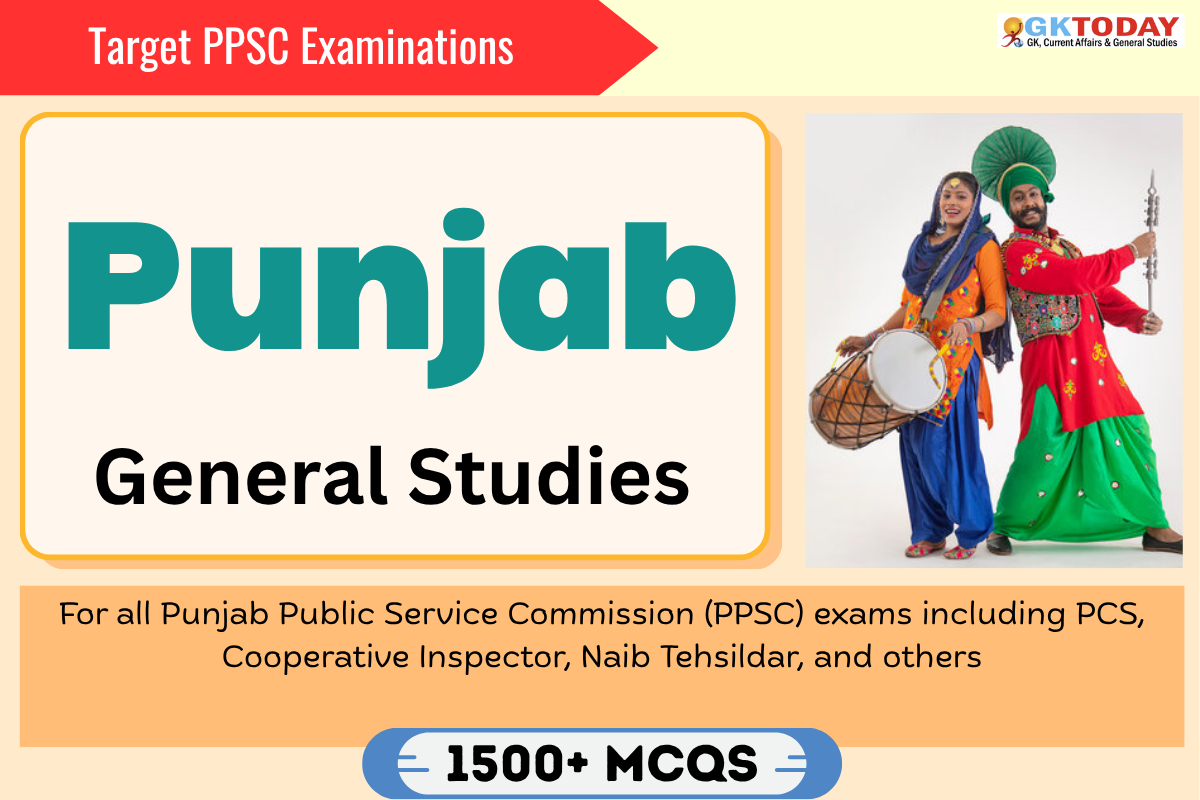States PCS: Punjab GK Questions for PPSC Examinations
For all Punjab Public Service Commission (PPSC) exams including PCS, Cooperative Inspector, Naib Tehsildar, and others.
1. Which ancient city in Punjab region served as a provincial capital under the Mauryan Empire?
[A] Taxila
[B] Multan
[C] Harappa
[D] Chandigarh
Show Answer
Correct Answer: A [Taxila]
Notes:
Taxila, located in ancient Punjab, was made a provincial capital by the Mauryan Empire. It was an important center of learning, home to the renowned ancient university, and a key administrative and cultural city during Chandragupta and Ashoka’s reigns.
2. What was the regular wing of the Sikh Khalsa Army called?
[A] Fauj-i-Khas
[B] Fauj-i-Ain
[C] Fauj-i-Be Qawaid
[D] Akali Nihangs
Show Answer
Correct Answer: B [Fauj-i-Ain]
Notes:
Fauj-i-Ain was the regular, modernized wing of the Sikh Khalsa Army under Maharaja Ranjit Singh. The elite wing was Fauj-i-Khas; irregulars were Fauj-i-Be Qawaid. The army included multiple communities and unique corps, and was known for its modernization, regimental structure, and distinct flags.
3. In which district does the Sarasa River join the Sutlej River?
[A] Solan
[B] Patiala
[C] Rupnagar
[D] Hoshiarpur
Show Answer
Correct Answer: C [Rupnagar]
Notes:
The Sarasa River, originating from Himachal Pradesh, merges with the Sutlej River in Rupnagar district, Punjab. The 1704 Battle of Sarsa occurred here. Gurudwara Parivar Vichora is on its banks near Majri village. The river faces pollution from nearby industrial areas.
4. Which Sikh Guru attained enlightenment at Kali Bein in Punjab?
[A] Guru Nanak Dev Ji
[B] Guru Gobind Singh
[C] Guru Arjan Dev Ji
[D] Guru Tegh Bahadur
Show Answer
Correct Answer: A [Guru Nanak Dev Ji]
Notes:
Guru Nanak Dev Ji attained enlightenment at Kali Bein in Sultanpur Lodhi, Punjab. Gurdwara Sri Ber Sahib marks the site. Kali Bein is a 160 km rivulet essential to the region’s ecology and culture. The rivulet was restored in the early 2000s by Sant Balbir Singh Seechewal.
5. Who from Hookran, Hoshiarpur, won the 1989 Sahitya Akademi for “Kahikashan”?
[A] Tara Singh Kamil
[B] Amrita Pritam
[C] Surjit Patar
[D] Avtar Singh Paash
Show Answer
Correct Answer: A [Tara Singh Kamil]
Notes:
Tara Singh Kamil (1929–1993), poet from Hookran, Hoshiarpur, received the Sahitya Akademi Award in 1989 for his poetry collection “Kahikashan”. He was noted for his contributions to Punjabi literature and his distinctive poetic style.
6. Who built the Manikyala Stupa in the Pothohar region (Punjab, Pakistan)?
[A] Kanishka
[B] Ashoka
[C] Chandragupta Maurya
[D] Harsha
Show Answer
Correct Answer: A [Kanishka]
Notes:
Manikyala Stupa was constructed during Kanishka’s reign (c. 128-151 CE). It houses Buddhist relics and is associated with Prince Sattva’s sacrifice according to Jataka tales. The stupa was later renovated and relics found there are preserved in the British Museum.
7. Which of the following are prominent types of early Sikh religious literature?
- Janamsakhis
- Gurbilas
- Vaaran
Select the correct option from codes given below:
[A] Only 1, 2 & 3
[B] Only 1 & 2
[C] Only 2 & 3
[D] Only 1 & 3
Show Answer
Correct Answer: A [Only 1, 2 & 3]
Notes:
Janamsakhis are biographical accounts of Gurus’ lives, Gurbilas are Sikh chronicles detailing Gurus’ lives and teachings, and Vaaran are long form poetic compositions about Sikh theology and history. All three are key types of early Sikh literature, each serving distinct literary and religious functions in the Sikh tradition.
8. Who established Jallianwala Bagh in Amritsar in 1812?
[A] Ranjit Singh
[B] Sardar Himmat Singh Bains
[C] Bhagat Singh
[D] Udham Singh
Show Answer
Correct Answer: B [Sardar Himmat Singh Bains]
Notes:
Jallianwala Bagh was established in 1812 by Sardar Himmat Singh Bains. It became infamous after the 1919 massacre. Located in Amritsar, Punjab, it is now a national memorial commemorating victims of the British attack led by General Dyer during India’s freedom movement.
9. Who was Maharaja Ranjit Singh’s court poet at Lahore Sikh Darbar?
[A] Waris Shah
[B] Amrita Pritam
[C] Qadir Yar
[D] Shiv Kumar Batalvi
Show Answer
Correct Answer: C [Qadir Yar]
Notes:
Qadir Yar (1802–1892), a Punjabi poet from Gujranwala, served as court poet under Maharaja Ranjit Singh at the Lahore Sikh Darbar. He is renowned for Punjabi Qissas and “Mehraj Nama,” reflecting the literary landscape of the Sikh Empire era.
10. Which Sikh Guru is honored at Gurdwara Mehdiana Sahib near Jagraon?
[A] Guru Nanak Dev
[B] Guru Gobind Singh
[C] Guru Tegh Bahadur
[D] Guru Arjan Dev
Show Answer
Correct Answer: B [Guru Gobind Singh]
Notes:
Gurdwara Mehdiana Sahib near Jagraon commemorates Guru Gobind Singh, who rested here after the 1705 Battle of Chamkaur and wrote the Zafarnamah. It is called the ‘School of Sikh History’, with sculptures depicting Sikh martyrs and events, and is an important Sikh pilgrimage site in Punjab.

